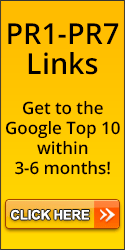A 5 Minute Guide to Google Penguin 2.0
 Since April of 2012 Google has been using its Penguin algorithm to help rank websites. Essentially, Penguin targets and lowers the rankings for websites that have bad link profiles, anchor text that is not properly written or too loaded with keywords, poor quality backlinks or overuses a single keyword or phrase. As of May 22, 2013 Google will be rolling out Penguin 2.0, which is a further evolved version of the original. Here is some information about Google Penguin 2.0, as well as what to do if your website has been penalized by Google Penguin.
Since April of 2012 Google has been using its Penguin algorithm to help rank websites. Essentially, Penguin targets and lowers the rankings for websites that have bad link profiles, anchor text that is not properly written or too loaded with keywords, poor quality backlinks or overuses a single keyword or phrase. As of May 22, 2013 Google will be rolling out Penguin 2.0, which is a further evolved version of the original. Here is some information about Google Penguin 2.0, as well as what to do if your website has been penalized by Google Penguin.
Why Penguin was Necessary
Google’s goal has always been to provide Internet searchers with the most relevant, well written and useful content. However, web designers and SEO experts quickly figured out ways to manipulate Google’s system to get their site to the top of search engine results. This resulted in millions of poorly written, plagiarized websites that were simply loaded with keyword phrases and didn’t contain any useful information.
This led Google to develop the Panda algorithm, which targeted website that had poorly written, copied or otherwise useless content. Google Panda forced web designers to rethink the ways that they generated content, as a site could be penalized if its content didn’t meet Google’s standards.
While Google Panda was designed to weed out poor content, Google Penguin was made to find links that are manipulative or unnatural. Bad link profiles happen for a number of reasons:
-If they come from a site that is poor quality
-Links that are on websites that are not related to your business or topic
-Links that have been paid for
-Links that are too loaded with keywords
-Links that have anchor text that is overly optimized
Sites that have these kinds of problems can be flagged by Google Penguin and given lower rankings, which can significantly lower the traffic the site is getting from Google searches.
A Quick Breakdown of Penguin 2.0
Most people are concerned whether Penguin 2.0 will target and work in the same way as its predecessor. Just like the first version, Penguin 2.0 is mainly designed to target spam and other sites that use unscrupulous tactics to increase their rankings and drive traffic to the site.
This means that people that have used shady tactics such as buying mass links, spamming sites with your links or leaving millions of comment (with links) on someone else’s blog will still find their sites penalized by Google Penguin 2.0.
The biggest difference is that Penguin 2.0 will go even deeper into the website to develop its rankings. Many websites have a well written home page but once you get into the internal pages they use the same black hat techniques that Google is trying to eliminate. Penguin 2.0 will also scan internal web pages on a site, which means shady SEO tactics will be sniffed out, even if they are not on the homepage.
Google expects that Penguin 2.0 will be able to effectively lower the rankings for all types of annoying spam sites.
How to Keep Your Rankings High
If you are worried about how Google Penguin 2.0 will affect your website’s rankings, then you need to know the steps to take to ensure your site meets Google’s standards. The primary way to stay in the good graces of Google Penguin is by ensuring your page has a good link profile. Here are some steps you can take:
- Know what you are looking for: If you are unaware of what makes a bad link profile then you should do a link audit on your site.
- Get rid of links to bad sites. If your site contains links to sites that are poor quality then it will be at risk for Google Penguin penalties. You should only link to sites that are well written, designed and have a strong presence on social media sites like Facebook.
- Make sure backlinks are relevant. You should only have backlinks on sites that are related to your niche or business. You should only post links on sites that are related to your business.
- Try to use only natural links. If your site gets a million backlinks over a short period of time it will send up a red flag to Google Penguin. This means you should probably avoid paid link services that deliver thousands of backlinks in a day.
- Look at every link. You should inspect every link that points to your site for quality. If you are unfamiliar with this process then you should hire a professional link auditor.
- Pay attention to anchor text. Be sure not to overload your anchor text with keywords.
- Get rid of those bad links. If you have any questionable links, get rid of them right away.
-Redo your site with good links. The best way to avoid Penguin penalties is to only use high quality links.











